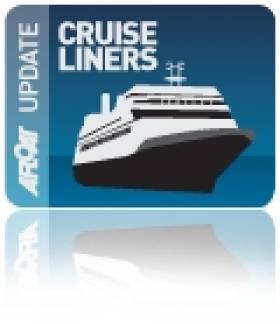Displaying items by tag: Louis Cruises
Sixties Sun-Seeker Still Rocks During Dublin Debut
#ClassicLinerLady – Louis Aura a classic cruiseship dating almost fifty years having been launched in the late 60's made her debut call to Dublin Port today, a first for Cypriot operator Louis Cruises, writes Jehan Ashmore.
Her call follows Belfast yesterday as previously reported, and her visit represents a new cruising region which otherwise is the eastern Mediterranean from Cyprus, Greece and Turkey.
Louis Cruises was founded in 1986 and was added to the Limassol based Louis Group which has operated since 1935. The operator runs Louis Aura on short cruises from Cyprus and her fleetmates, Louis Crystal and Louis Olympia this season offering 4 to 7 days cruises from Greece and Turkey.
The veteran 16,000 tonnes was launched in 1968, though she had a major refit in 2005 to increase her lifespan. Only last year she was renamed having been Orient Queen and before that Bolero. This follows a career first starting as Starward which was geared for the U.S. market running under Norwegian Caribbean Lines.
Her cruising grounds of the balmy Caribbean embraced a design to reflect her environment where a three-deck high sun-lounge which is partially enclosed is sited above the bridge.During service for NCI this popular spot named the Tropicana Garden with its 'Skybars' next to the adjoining sheltered lido-area would became particular hot due to such humid conditions.
Here a spiral staircase links two decks which overlook the aft swimming pool again partially sheltered by the glazed screen walls of this feature which was ahead of its time. Fortunately these bars remain to quench a thirst while overlooking the Hera Deck below with its swimming pool.
For further details included photo of facilities for more than 800 cruise-goers, plus views of staterooms and corresponding deck plans, take a peek by clicking this LINK.
In addition the open promenade deck with lifeboats is a refreshing feature which is an increasingly unique feature compare to modern cruiseships which also lack cruiser-sterns, having said that the added superstructure somewhat spoils the aft deck. While at the opposite 'end' of the vessel at the bow is where a former cargo-hold along with derricks is now where a heli-pad is located.
Despite these changes, she still retains exterior styling by Knud E. Hansen of Copenhagen, from where her Scandinavian ferry origins included a vehicle deck to carry freight-trailers between Miami, the Bahamas and Jamaica.
This ability to carry vehicles has long since gone and was never a feature of her pure cruise sister. Skyward which too was commissioned by NCL from the yard of AG Weser Seebeckwerft in Bremen.
Her stylised twin funnel uptakes are particularly streamlined and positioned further aft to accentuate a slick profile superstructure.
This evening she is due to depart at 20.00hrs having spent a stunningly sunny day under Irish climes! It is understood her next port of call is Portsmouth.
Stylish Sixties Classic Becomes Newcomer to Belfast Harbour
#CruiseClassic – Belfast Harbour welcomed Louis Aura (1968/16,781grt) on her first visit to the port yesterday having cruised in Scottish waters, the caller been the first of three new visitors due this season to the port, writes Jehan Ashmore.
Louis Aura is operated by Cypriot based Louis Cruises which normally operate services in the eastern Mediterranean throughout the Aegean Islands, Turkey and Cyprus.
Only last year the veteran vessel was renamed for further service in a career that stretches almost five decades ago. The former Orient Queen underwent a major refit in 2005 to extend the vessel's prospects that originally stemmed from serving service in the Caribbean. This involved Miami-Bahamas and Jamaica. She would later become Bolero for service elsewhere.
Launched as the Starwind, she followed predecessor and trendsetter Sunward ordered for Norwegian Caribbean Line to serve the U.S. market in which her '60's styling in terms of exterior is clearly evident of that era.
Note the glazed three-deck wraparound sun lounge feature above the bridge. This is where the Panoramic and Zeus Decks form double bar areas overlooking the sheltered sun-bathing area and swimming pool on Hera Deck (as above click link for aerial photo). Such a feature leads to the streamlined twin funnel uptakes that sweep along the profile forming a rather aerodynamic superstructure.
Together they were pioneering in design from the distinctive hand of Danish naval architects Knud E. Hansen A/S. notably world renowned for their cruiseships and car-ferries.
The call of Louis Cruises to Belfast is a boost for the cruise sector visiting Northern Ireland and of subsequent newcomers due this season, Berlin and Club Med 2.
Overnight Louise Aura departed Stormont Wharf and arrived into Dublin Port this morning on what was also her debut call to the capital. She berthed in Alexandra Basin, where Fred Olsen Cruise Lines Black Watch which too had called from Belfast had previously made a mid-week call.
























